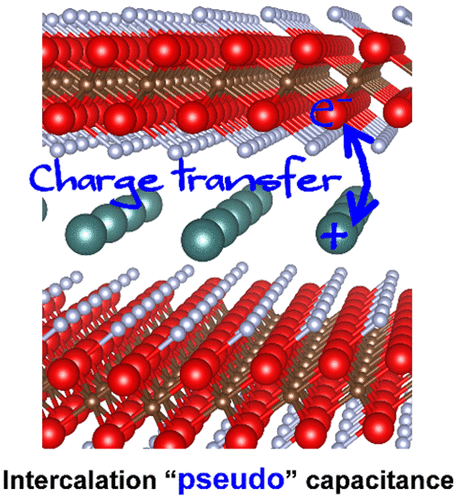当前位置:
X-MOL 学术
›
Acc. Chem. Res.
›
论文详情
Our official English website, www.x-mol.net, welcomes your feedback! (Note: you will need to create a separate account there.)
MXene as a Charge Storage Host
Accounts of Chemical Research ( IF 18.3 ) Pub Date : 2018-02-22 00:00:00 , DOI: 10.1021/acs.accounts.7b00481 Masashi Okubo 1, 2 , Akira Sugahara 1 , Satoshi Kajiyama 1 , Atsuo Yamada 1, 2
Accounts of Chemical Research ( IF 18.3 ) Pub Date : 2018-02-22 00:00:00 , DOI: 10.1021/acs.accounts.7b00481 Masashi Okubo 1, 2 , Akira Sugahara 1 , Satoshi Kajiyama 1 , Atsuo Yamada 1, 2
Affiliation

|
The development of efficient electrochemical energy storage (EES) devices is an important sustainability issue to realize green electrical grids. Charge storage mechanisms in present EES devices, such as ion (de)intercalation in lithium-ion batteries and electric double layer formation in capacitors, provide insufficient efficiency and performance for grid use. Intercalation pseudocapacitance (or redox capacitance) has emerged as an alternative chemistry for advanced EES devices. Intercalation pseudocapacitance occurs through bulk redox reactions with ultrafast ion diffusion. In particular, the metal carbide/nitride nanosheets termed MXene discovered in 2011 are a promising class of intercalation pseudocapacitor electrode materials because of their compositional versatility for materials exploration (e.g., Ti2CTx, Ti3C2Tx, V2CTx, and Nb2CTx, where T is a surface termination group such as F, Cl, O, or OH), high electrical conductivity for high current charge, and a layered structure of stacked nanosheets for ultrafast ion intercalation. Various MXene electrodes have been reported to exhibit complementary battery performance, such as large specific capacity at high charge/discharge rates. However, general design strategies of MXenes for EES applications have not been established because of the limited understanding of the electrochemical mechanisms of MXenes. This Account describes current knowledge of the fundamental electrochemical properties of MXenes and attempts to clarify where intercalation capacitance ends and intercalation pseudocapacitance begins.
中文翻译:

MXene作为电荷存储主机
高效电化学能量存储(EES)设备的开发是实现绿色电网的重要可持续性问题。当前的EES设备中的电荷存储机制,例如锂离子电池中的离子(去)插层和电容器中的双电层形成,为电网使用提供了不足的效率和性能。插层伪电容(或氧化还原电容)已作为高级EES器件的替代化学方法出现。插入假电容通过具有超快离子扩散的本体氧化还原反应发生。尤其是,2011年发现的名为MXene的金属碳化物/氮化物纳米片由于其在材料勘探中的组成多功能性(例如Ti 2CT x,Ti 3 C 2 T x,V 2 CT x和Nb 2 CT x,其中T是表面终止基团(例如F,Cl,O或OH),具有高电导率的高电流电荷,以及用于超快离子嵌入的堆叠纳米片的层状结构。已经报道了各种MXene电极表现出互补的电池性能,例如在高充电/放电速率下的大比容量。但是,由于对MXene的电化学机理的了解有限,因此尚未建立用于EES应用的MXene的通用设计策略。该帐户描述了有关MXene的基本电化学性质的当前知识,并试图阐明插层电容在何处终止和插层伪电容在何处开始。
更新日期:2018-02-22
中文翻译:

MXene作为电荷存储主机
高效电化学能量存储(EES)设备的开发是实现绿色电网的重要可持续性问题。当前的EES设备中的电荷存储机制,例如锂离子电池中的离子(去)插层和电容器中的双电层形成,为电网使用提供了不足的效率和性能。插层伪电容(或氧化还原电容)已作为高级EES器件的替代化学方法出现。插入假电容通过具有超快离子扩散的本体氧化还原反应发生。尤其是,2011年发现的名为MXene的金属碳化物/氮化物纳米片由于其在材料勘探中的组成多功能性(例如Ti 2CT x,Ti 3 C 2 T x,V 2 CT x和Nb 2 CT x,其中T是表面终止基团(例如F,Cl,O或OH),具有高电导率的高电流电荷,以及用于超快离子嵌入的堆叠纳米片的层状结构。已经报道了各种MXene电极表现出互补的电池性能,例如在高充电/放电速率下的大比容量。但是,由于对MXene的电化学机理的了解有限,因此尚未建立用于EES应用的MXene的通用设计策略。该帐户描述了有关MXene的基本电化学性质的当前知识,并试图阐明插层电容在何处终止和插层伪电容在何处开始。



























 京公网安备 11010802027423号
京公网安备 11010802027423号